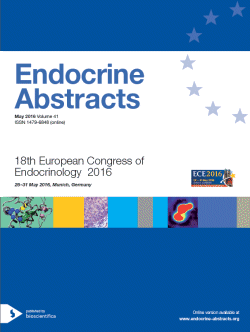Guided Posters
Bone & Calcium Homeostasis
ea0041gp31 | Bone & Calcium Homeostasis | ECE2016
Bone-specific circulating miRNA profile changes over an 8-week repeated sprint training protocol
Lombardi Giovanni , Sansoni Veronica , Perego Silvia , Vernillo Gianluca , Bonzanni Mattia , Merati Giampiero , Barbuti Andrea , La Torre Antonio , Banfi Giuseppe
ea0041gp32 | Bone & Calcium Homeostasis | ECE2016
Hormone replacement therapy has favorable effects on bone microarchitecture, bone mineral density and body fat mass, without affecting lean mass: the OsteoLaus Cohort
Papadakis Georgios , Hans Didier , Vollenweider Peter , Waeber Gerard , Preisig Martin , Marques-Vidal Pedro , Lamy Olivier
ea0041gp33 | Bone & Calcium Homeostasis | ECE2016
Relationships between lower-limb muscle strength and tibial outcomes in ageing UK men
Zengin Ayse , Pye Stephen R , Cook Michael J , Adams Judith E , Wu Frederick C W , O'Neill Terence W , Ward Kate A
ea0041gp35 | Bone & Calcium Homeostasis | ECE2016
Retrospective analysis of bone metabolism in patients waiting for simultaneous pancreas kidney transplantation
Kratochvilova Simona , Zahradnicka Martina , Brunova Jana
ea0041gp36 | Bone & Calcium Homeostasis | ECE2016
Fontan palliation in children is associated with bone deficits
Petryk Anna , Polgreen Lynda E , Brown Roland , Marino Bradley S , Gremmels David , Shepard Charles , Kelly Aaron S , Miller Bradley S , Rudser Kyle , Kochilas Lazaros K
ea0041gp37 | Bone & Calcium Homeostasis | ECE2016
Trabecular bone score in patients with inflammatory bowel diseases
Krajcovicova Anna , Kuzma Martin , Kaniaris Aristodimos Grigorios , Killinger Zdenko , Hlavaty Tibor , Payer Juraj
ea0041gp38 | Bone & Calcium Homeostasis | ECE2016
Influence of prematurity and low birth weight on peak bone mass
Balasuriya Chandima , Mosti Mats P , Evensen Kari Anne I , Brubakk Ann-Mari , Indredavik Marit S , Schei Berit , Stunes Astrid Kamilla , Syversen Unni
ea0041gp39 | Bone & Calcium Homeostasis | ECE2016
Drug holiday in osteoporosis. reducing side effects of long lasting treatments
Athanassiou Panagiotis , Pantazi Eleni , Skioti Ourania , Tzanavari Aikaterini , Kostoglou-Athanassiou Ifigenia
ea0041gp40 | Bone & Calcium Homeostasis | ECE2016
Severe osteomalacia caused by a phosphaturic mesenchymal tumor secreting fibroblast growth factor 23: a case report
Ravarani Lisa , Faust Michael , Quaas Alexander , Bludau Marc , Schmidt Matthias , Allendorf Inka , Topuzoglu-Muller Tengu , Hanszen Ruth , Schary Oliver , Bruning Jens C




